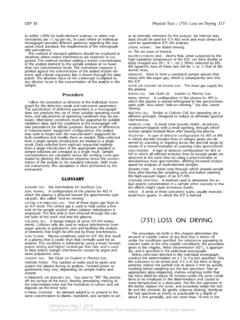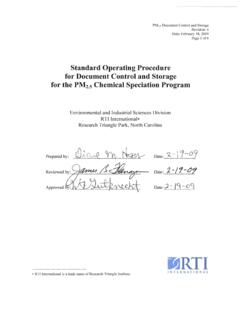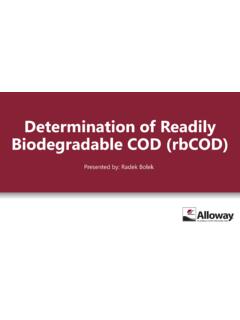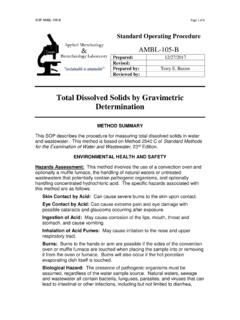Transcription of Lesson A 1 CHARACTERISTIC, ANALYTIC AND SAMPLING …
1 EMWATER E-LEARNING COURSE PROJECT FUNDED BY THE EUROPEAN UNION Lesson A1: CHARACTERISTIC, ANALYTIC AND SAMPLING OF WASTEWATER Lesson A 1 CHARACTERISTIC, ANALYTIC AND SAMPLING OF WASTEWATER Author: G ksel Akcin*, znur Alp*, Holger Gulyas** Birgit B st** *Chemistry Department Faculty of Science and Art Yildiz Technical University Istanbul **Institute of Wastewater Management Hamburg University of Technology Revised by Dr. Yavuz zoguz data-quest Suchi & Berg GmbH Keywords Domestic wastewater characteristics , ANALYTIC parameters, SAMPLING and determination technique Page 2 of 49 EMWATER E-LEARNING COURSE PROJECT FUNDED BY THE EUROPEAN UNION Lesson A1: CHARACTERISTIC, ANALYTIC AND SAMPLING OF WASTEWATER Table of content Overview and summary of this Lesson .
2 2 1. Domestic wastewater sources and its 2. Definition and measurement of wastewater Physical parameters ..6 Turbidity ..10 Colour ..10 Temperature ..10 Odour ..11 Chemical Alkalinity ..11 Dissolved Oxygen (DO)..13 Biochemical Oxygen Demand (BOD) ..14 Chemical Oxygen Demand (COD) ..15 Total Organic Carbon (TOC) ..17 Interrelationship between BOD, COD and TOC ..18 Chlorides ..18 Nitrogen ..19 Phosphorus ..22 Oil and Grease ..24 Adsorbable organic halides (AOX) ..25 Selected other parameters.
3 26 3 SAMPLING and preparation techniques of wastewater 4 5. Working 6. Controlling of process of a wastewater treatment plant ..43 7. References ..45 Appendix ..47 Overview and summary of this Lesson Wastewater is the term for discarded or previously used water from a municipality or industry. The wastewater that is produced due to human activities in households is called domestic wastewater wastewater from the kitchen, bathroom, toilet and Page 3 of 49 EMWATER E-LEARNING COURSE PROJECT FUNDED BY THE EUROPEAN UNION Lesson A1: CHARACTERISTIC, ANALYTIC AND SAMPLING OF WASTEWATER laundry.
4 Such water usually contains dissolved as well as suspended matter and must be treated prior to its discharge into natural water. To examine the quality of wastewater to be discharged into aquatic environment or to be treated and reused, the characteristics of wastewater in question must be defined precisely. Quantitative assessments of the quality of wastewater are made by considering many criteria, including temperature, dissolved oxygen level and concentration of organic as well as inorganic compounds.
5 The most frequently used parameters are: Biochemical Oxygen Demand (BOD), Chemical Oxygen Demand (COD), Total Organic Carbon (TOC), Alkalinity, Chlorides, Nitrogen, Oil and Grease, Dissolved Oxygen, pH, Phosphorus, Gases, Sulphur, Solids, Temperature, Metals as well as Micro-organisms. In this Lesson , these parameters are defined and methods for analysing them are discussed briefly. In addition SAMPLING and determination techniques are discussed. 1. Domestic wastewater sources and its characteristic Wastewater is the water which is disposed from homes, offices and industry.
6 It comes from toilets, sinks, showers, washing machines and industrial processes and was historically called sewage. Fehler! Keine Indexeintr ge 1: Sources of domestic wastewater (Samwel 2005) Wastewater produced due to human activities in households is called domestic wastewater wastewater from the kitchen, shower, wash basin, toilet and laundry (see figure 1). It is defined as follows: Page 4 of 49 EMWATER E-LEARNING COURSE PROJECT FUNDED BY THE EUROPEAN UNION Lesson A1: CHARACTERISTIC, ANALYTIC AND SAMPLING OF WASTEWATER - yellow water: human urine - brown water: human faeces with flushed water (can include paper if used) - black water: human faeces (brown water) mixed with urine (yellow water), in general: wastewater from toilets.
7 It contains human waste and can be a public health risk if not treated properly. (Sometimes, water used in kitchen is also classified as black water) - grey water: water used in the kitchen, bathroom including sinks, baths, showers and laundry, etc. or any water that has been used at home, except water from toilets The strength and composition of the domestic wastewater changes on hourly, daily and seasonal basis, with the average strength dependent on per capita water usage, habits, diet, living standard and life style.
8 The main reason is variation in water usage in households. Households in developed countries use more water than those in developing countries. Wastewater components can be divided into different main groups as shown in Table 1. They can adversely affect the aquatic life if discharge them into environmental. Table :1 Components present in domestic wastewater (Henze and Ledin; 2001) Component Of special interest Environmental effect Microorganisms Pathogenic bacteria, virus and worms eggs Risk when bathing and eating shellfish Biodegradable organic materials Oxygen depletion in rivers and lakes Fish death, odours Other organic materials Detergents, pesticides, fat, oil and grease, colouring, solvents, phenols, cyanide Toxic effect, aesthetic inconveniences, bioaccumulation in the food chain Nutrients Nitrogen, phosphorus, ammonium Eutrophication, oxygen depletion, toxic effect Metals Hg, Pb, Cd.
9 Cr, Cu, Ni Toxic effect, bioaccumulation Other inorganic materials Acids, for example hydrogen sulphide, bases Corrosion, toxic effect Thermal effects Hot water Changing living conditions for flora and fauna Odour (and taste) Hydrogen sulphide Aesthetic inconveniences, toxic effect Radioactivity Toxic effect, accumulation Physically, domestic wastewater is usually characterised by a grey colour, musty odour and has a solids content of about The solid material is a mixture of faeces, food particles, toilet paper, grease, oil, soap, salts, metals, detergents, sand and grit.
10 The solids can be suspended (about 30%) as well as dissolved (about 70%). Dissolved solids can be precipitated by chemical and biological processes. From a physical point Page 5 of 49 EMWATER E-LEARNING COURSE PROJECT FUNDED BY THE EUROPEAN UNION Lesson A1: CHARACTERISTIC, ANALYTIC AND SAMPLING OF WASTEWATER of view, the suspended solids can lead to the development of sludge deposits and anaerobic conditions when discharged into the receiving environment. Chemically, wastewater is composed of organic (70%) and inorganic (30%) compounds as well as various gases.






